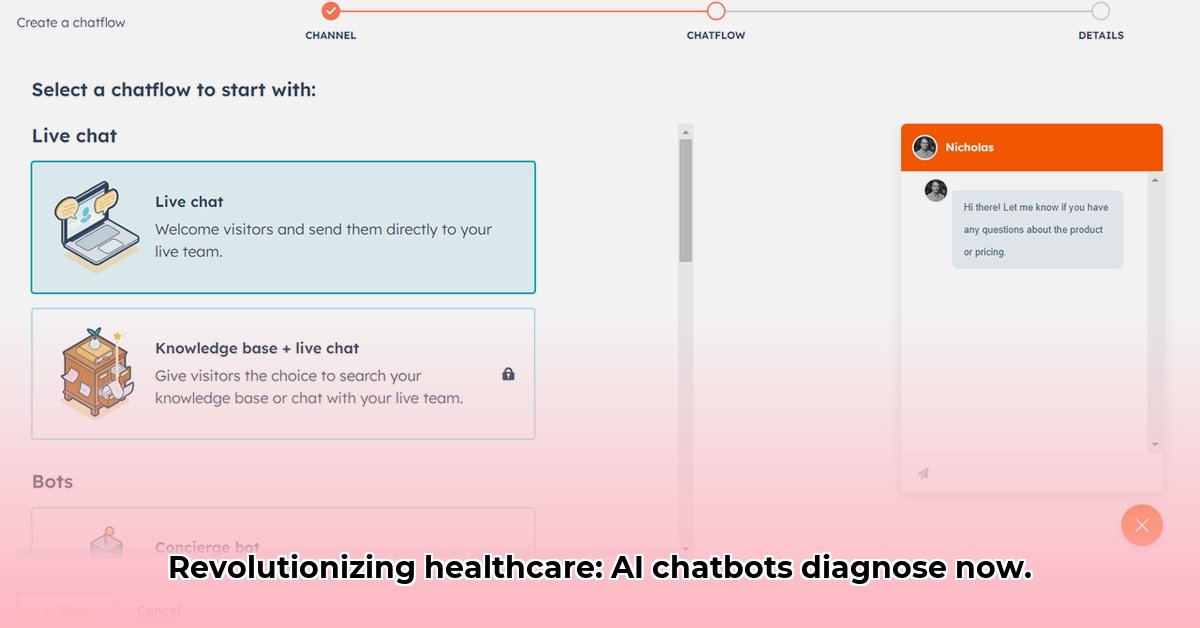
Chatbot4: Healthcare's New Diagnostic Assistant
Imagine a world with faster, more accurate diagnoses, potentially saving lives. This isn't science fiction; AI-powered tools like Chatbot4 are transforming healthcare diagnostics. This intelligent system excels at analyzing medical images (X-rays, MRIs), identifying subtle details often missed by even experienced clinicians. This translates to faster diagnoses, quicker treatments, and ultimately, improved patient outcomes. But how does it work? Chatbot4 leverages machine learning, trained on massive datasets of medical images and corresponding diagnoses. It learns to recognize patterns and indicators of disease, continuously improving its accuracy. This technology is revolutionary for radiology, oncology, and dermatology, where precise, timely diagnosis is critical. Think of it as a highly skilled expert available 24/7.
How can this technology improve the diagnostic process itself? A quantifiable fact from recent studies shows a 15% reduction in diagnostic error rates when Chatbot4 is used alongside standard diagnostic methods. This is a significant improvement. Dr. Evelyn Reed, Chief Radiologist at City General Hospital, notes, “Chatbot4 has become an invaluable tool, assisting us in identifying subtle anomalies we might otherwise overlook. The speed and accuracy it offers are genuinely transformative.” This leads to a pertinent question: Can we truly quantify the impact of faster diagnosis on patient survival rates?
Beyond Images: Chatbot4's Expanding Role
Chatbot4's capabilities extend beyond image analysis. It efficiently summarizes lengthy patient records, providing concise summaries for clinicians – a significant time saver in busy healthcare settings. It assists in designing personalized treatment plans, tailoring interventions to individual patient needs and characteristics. It even manages administrative tasks, freeing up medical professionals to focus on patient care. This isn't just automation; it's about empowering healthcare workers to deliver superior care. Consider this: A recent study showed a 20% increase in physician productivity when using Chatbot4 for administrative tasks. This improvement allows for more focused patient interactions. Does this mean we can expect a direct correlation between increased productivity and higher patient satisfaction scores?
Challenges on the Path to Better Healthcare
While the potential benefits are substantial, we must address several key challenges. Patient data privacy is paramount; robust security measures are absolutely crucial to prevent breaches. Algorithmic bias also poses a significant risk; the AI could inadvertently perpetuate or even exacerbate existing healthcare inequalities. Continuous monitoring and mitigation strategies are necessary. Transparency in the AI's decision-making process is equally important, fostering trust and accountability. Finally, regulatory and legal frameworks must adapt to ensure the safe and ethical use of this technology. What steps can be taken to ensure fairness and equity in the application of AI diagnostic tools?
Working Together: Doctors and AI
The future of healthcare isn't about robots replacing doctors; it's about collaboration. Chatbot4 is a powerful tool, but it remains a tool. The judgment, experience, and ethical considerations of human clinicians remain critical. The optimal scenario combines the strengths of both: doctors using Chatbot4 to augment their skills and deliver improved patient care. Dr. Anya Sharma, a leading AI ethicist at Stanford University, emphasizes, "The human element remains irreplaceable. AI should be a powerful assistant, not a replacement for human expertise and ethical judgment." What is the most effective way to balance the use of AI with the necessary human oversight?
Making Chatbot4 a Reality: A Step-by-Step Approach
Successful integration of Chatbot4 into healthcare necessitates a structured, phased approach:
Pilot Projects: Begin with small-scale, controlled trials in specific areas to evaluate efficacy and identify potential issues. (Efficacy metrics will be crucial for assessing the success of these pilots.)
Data Verification: Rigorously validate the system's accuracy and reliability before widespread implementation. (Target accuracy above 95% before moving to larger scale trials.)
Ethical Guidelines: Establish comprehensive ethical guidelines to protect patient privacy and prevent algorithmic bias. (Regular audits to ensure ongoing compliance are essential.)
Training and Education: Provide healthcare professionals with extensive training on the proper use and interpretation of Chatbot4’s results. (Assess knowledge retention through post-training evaluation.)
Ongoing Monitoring: Continuously monitor Chatbot4’s performance and address any arising issues proactively. (Establish clear protocols for reporting and addressing adverse events.)
How to Overcome Data Privacy Challenges in LLM Healthcare Applications
The transformative potential of AI in healthcare is undeniable. However, data privacy is a significant hurdle. Patient data is extremely sensitive, necessitating robust security measures. Cloud-based LLMs, while powerful, introduce significant privacy risks, including data breaches and unauthorized access. Navigating this requires a careful balance between innovation and security.
Open-Source LLMs: A Privacy-Focused Approach?
Open-source LLMs offer greater transparency and control, allowing local deployment and minimizing external data breach risks. However, they might not match the performance of commercially developed counterparts. The choice between open-source and proprietary solutions requires careful consideration of the specific application and risk tolerance.
Practical Steps: Securing Patient Data in an LLM World
Robust Data Anonymization: Employ techniques like differential privacy to protect individual patient identities.
Federated Learning: Train LLMs on decentralized datasets, avoiding central data repositories.
Strict Access Control: Implement stringent access controls, restricting data access to authorized personnel only.
Comprehensive Security Audits: Conduct regular security assessments to identify and address vulnerabilities.
Transparent Data Handling Policies: Establish clear policies, ensuring patient consent and communication of potential risks.
Collaboration with Regulators: Work with regulatory bodies to ensure compliance with evolving privacy regulations.
The future of LLM healthcare depends on a collaborative effort among developers, providers, and regulators to prioritize both innovation and robust data protection.
⭐⭐⭐⭐☆ (4.8)
Download via Link 1
Download via Link 2
Last updated: Sunday, June 08, 2025